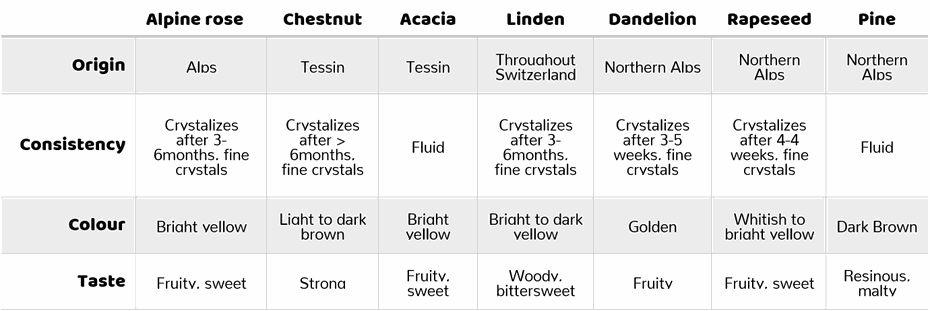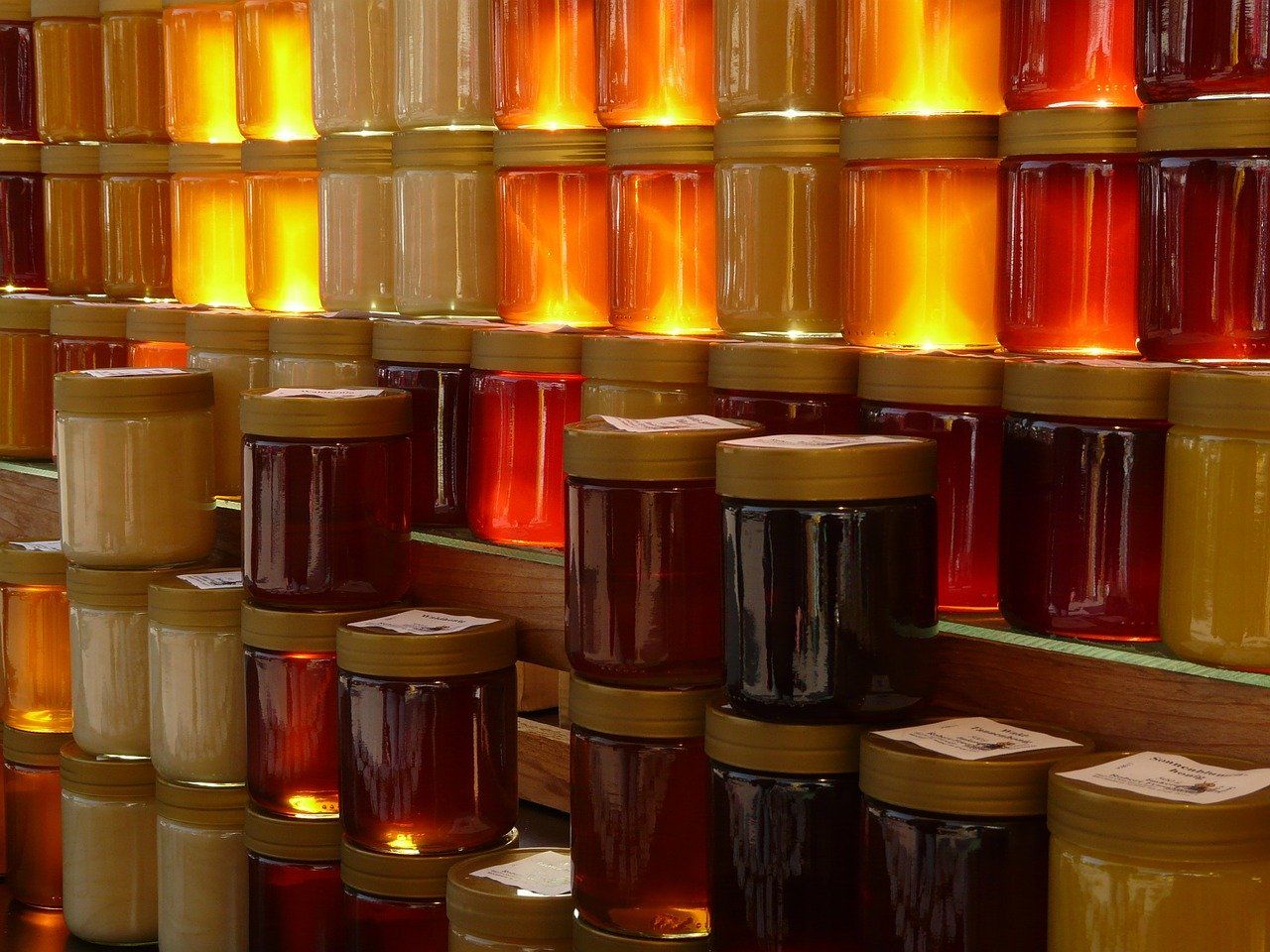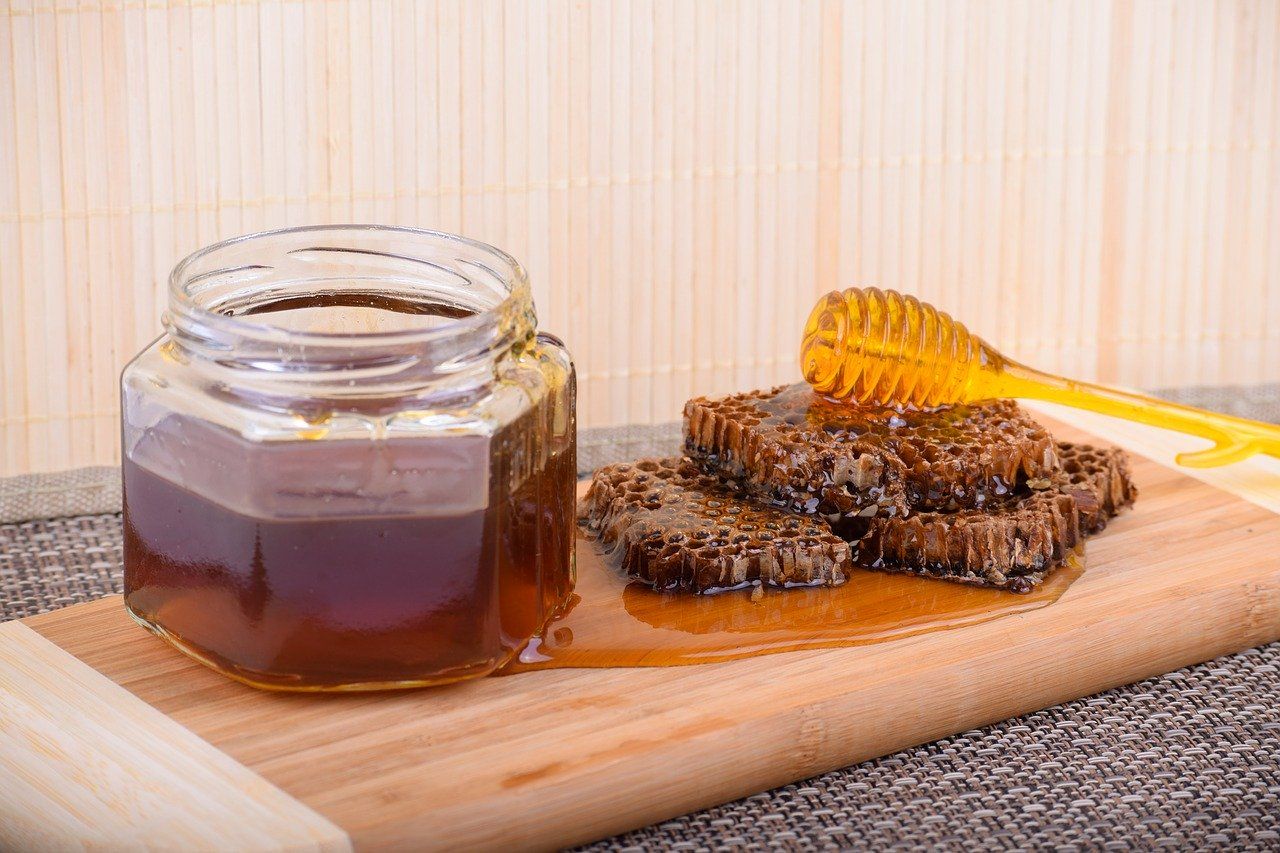The number of honey varieties are endless, honey can be organic, local, natural, raw, come from one specific flower or multiple. So what do all these terms actually mean? To help you find your way through the maze of different terms, we provide you with an overview of the most important types of honey to help you understand what’s inside a honey jar.
To create honey, honeybees collect nectar from flowers and add some enzymes of their own. These make the honey preservable and also easier to digest. More on how honey is created can be found in our article «How honeybees create honey».
All honeys roughly consist of 80% sugars (which is made up of varying amounts of fructose and glucose) and around 16-20% water. Additionally, honey also contains small amounts of proteins, amino acids, minerals and vitamins which gives the honey extra nutritional value. In this overview we explain the different types of honey based on their origin, the way honey is processed and compare organic and regular honey.
Different origins of honey
The taste, color, smell and consistency can differ widely and depends on the type of flower from which the nectar is collected and how the honey is processed. The different nectar sources of honey results in four different categories:
Mono-floral honey
Multi-floral honey
Honeydew honey
Local honey
Mono-floral
This is honey which comes from one specific plant which result in a very specific taste or other characteristics. However, producing mono-floral honeys can be a challenge as bees collect nectar from any flower they like. Therefore, if more than 50% of the nectar in the honey comes from one particular plant, it can be classified as mono-floral. These honeys are often produced in areas with large monocultures and the bees are moved to this location when the particular plants blossoms. A list of common mono-floral honeys is shown in the table below..

Multi-floral
Also called wildflower honey, is the most common type of honey you find and is collected from a variety of plants. These honeys typically have a rich taste and as the honey stems from a variety of nectar sources. Multi-floral honey usually comes at a cheaper price, as it is easier to produce.
Honeydew
This is a bit of an odd one, as honeydew honey (also known as forest honey) does not stem from nectar but from honeydew. Honeydew is a sugar-rich substance produced by aphids. Bees tend to favor nectar, but if this is not available they collect honeydew instead. Honeydew can be either part of a multi-floral honey or sold as mono-floral. If you want to learn more about this special type of honey and its benefits, read our blog post on honeydew.
Local honey
Local honeys are honey types which are from a specific region, pretty straightforward. Buying local honey is a great way to support local beekeepers whose bees are doing an important job pollinating flowers and crops in the area.

Do these differences even matter?
Well this all comes down to personal preferences, mono-floral honey can be very specific and for some recipe and strong flavored honey such as pine honey might be preferred over a mild honey such as acacia honey. Alternatively the creamy consistency of clover honey is quite practical if you want to avoid honey dripping over the edges of your bread. A simple rule of the thumb: The darker the honey, the stronger the taste.
Processing
Beside it’s origin, the way the honey is processed also has a large influence. Most honey is filtered and pasteurized, however these processes can result in a milder taste and also remove valuable nutrients, which is why some people prefer «raw» honey. Based on how the honey is processed we can classify honey into regular natural, pure and raw honeys.
Regular honey
This is the broadest category and refers to most of the honeys on the market. These types of honey are extensively filtered and pasteurized (heated) which avoids the crystallization. Crystallized honey is perfectly fine to eat, however the consistency can be a bit unpractical to handle and a clear and bright honey often looks better on a supermarket shelf.
Natural honey
Natural honey can be a bit of a confusing term, as honey is a natural product anyways. Natural means that there are no artificial additives, which should not be in the honey anyways. So, natural honey is usually not very different compared to regular honey.
Pure honey
Pure honey is honey without any additives (artificial or natural), such as sugars or flavorings. Of course to get pure honey, lots of filtration is needed.
Raw
The downside of pasteurization process is that the heating can destroy healthy minerals and vitamins. Therefore honey is also sold raw, this honey is straight from the combs and is not filtered or heated. In this way the honey contains all of its the beneficial nutrients. Raw honey is considered to be the healthiest type of consuming honey [1].

Organic honey
Regulations on organic honey can differ between countries, however organic honey always has regulations on the way the beekeepers keeps his bees, the area in which the bees are foraging and how the honey is processed. For example beekeepers have to keep bees in bee hives made from wood or other natural materials (so not plastic ones). Also, the foraging area of the bees should be on organic land (usually a 3 to 5 km radius). This can be tricky as the beekeeper is dependent on landowners around the apiary. Finally, organic honey is usually filtered but not pasteurized.
Conclusion
There are numerous honey types out there and the best way to find your favorite is by trying them out! Most honeys you find in the supermarket are multi-floral and are processed as regular honey or organic. However, we hope that also a complex label such as «local, raw honeydew honey» which you find in specialist shops or online appears a bit less confusing by now.
Literature
[1] Berry, J. (2019 April, 15th). How are raw honey and regular honey different? Medical News Today. https://www.medicalnewstoday.com/articles/324966.php